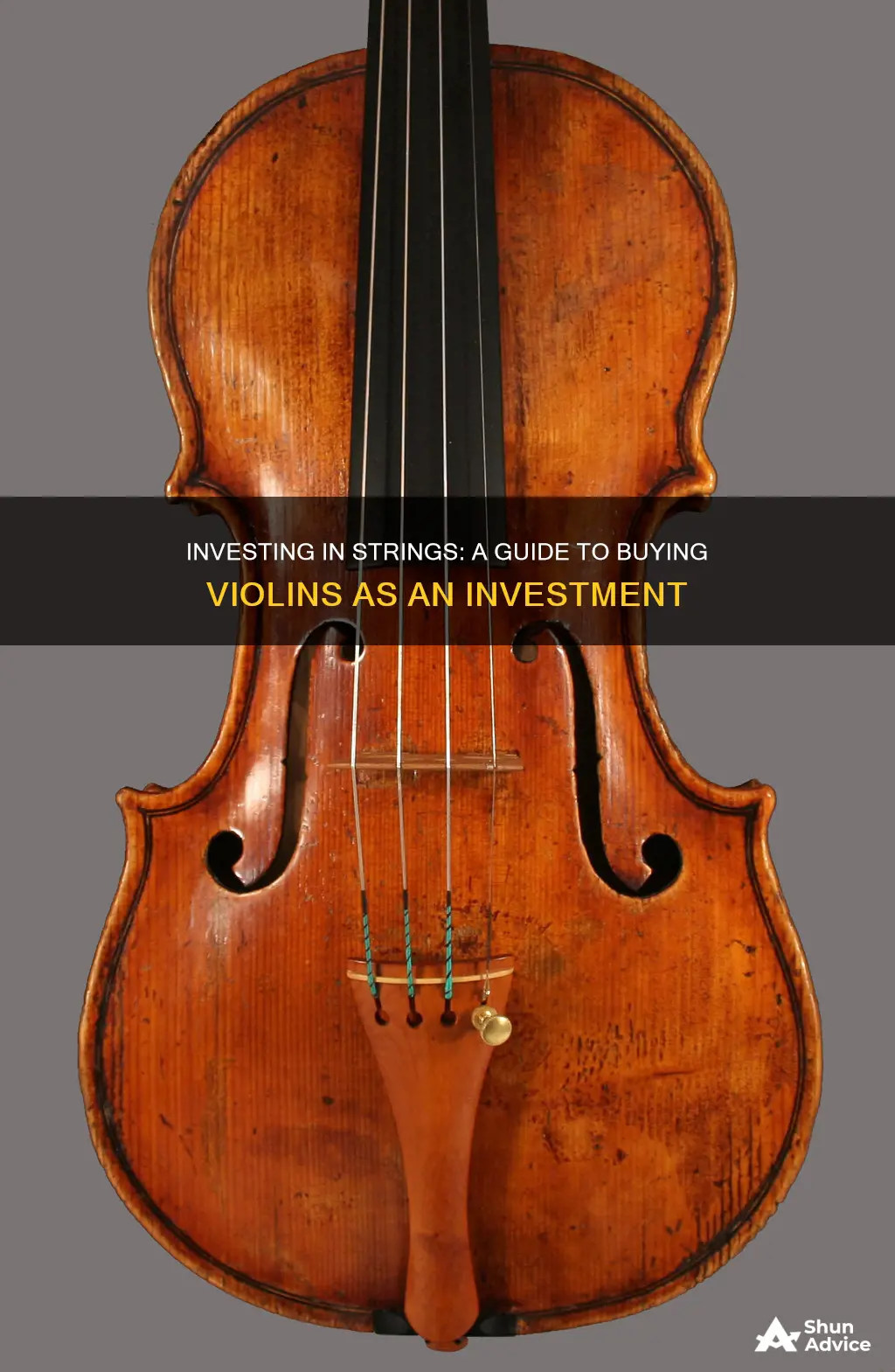
Investing in a violin is not just about buying an instrument—it's about acquiring a piece of history that can appreciate in value over time. When considering investing in violins, there are two main categories: contemporary and antique. Antique violins, typically those made before the 20th century, are often the most valuable and sought-after. However, they come with risks like authenticity and condition. On the other hand, contemporary violins are easier to acquire, more affordable, and may have a more consistent sound quality.
Regardless of the type of violin, investors must conduct thorough research and carefully evaluate various factors, including the maker, condition, rarity, and market demand. It is also crucial to seek out reputable dealers and experts for guidance. While a good-sounding violin is important, it is not the sole factor in determining its investment potential.
| Characteristics | Values |
|---|---|
| Purpose of investment | Profit in the future or an instrument that fits your playing style and sound ideals |
| Instrument type | Rare and in high demand |
| Instrument condition | Good condition, with inevitable historic repairs |
| Instrument maker | Established with solid demand |
| Instrument research | Research the history and provenance of the violin or maker |
| Instrument appraisal | Get an accurate estimate of the violin's value from a qualified expert or reputable dealer |
| Antique violins | Not necessarily valuable because of their age; the maker, condition and provenance will affect the price |
| Dealer | Find a reputable dealer |
What You'll Learn

Research the violin's history and maker
Researching the history of a violin and its maker is an essential step when investing in a violin. This due diligence will help you understand how much the instrument may be worth in the future.
Firstly, it is important to research the violin's maker. Antique violins, typically those made before the 20th century, are often considered the most valuable and sought-after by collectors and investors. Violins made by well-known makers such as Stradivarius, Guarneri del Gesu, Amati, and Guadagnini are particularly desirable. These violins are considered works of art and have a unique and desirable sound that cannot be replicated by modern instruments. Investing in antique violins, however, can be risky due to issues of authenticity, condition, and potential legal restrictions on ownership and sale.
On the other hand, contemporary violins are generally easier to acquire and more affordable. They may also have more consistent and predictable sound quality due to the use of modern materials and techniques. Investing in contemporary violins is also a way to support and encourage the work of living luthiers. However, the value of contemporary violins may not increase as quickly as antique instruments, and the market for them may be less established and predictable.
Whether investing in an antique or contemporary violin, it is crucial to research the maker's reputation, training, craftsmanship, and unique selling points. For antique violins, the history of the maker and the period in which they were active is especially important. For contemporary violins, look into whether the maker has a roster of well-known players who use their instruments, as this will validate the maker from a musician's perspective.
In addition to the maker, it is also essential to research the history of the violin itself. This includes evaluating the violin's condition, rarity, provenance, and any repairs or restorations that have been carried out. A well-maintained violin in good condition will have a higher value. The type of repair and how well it was executed can also impact the value of the instrument.
By thoroughly researching both the violin and its maker, you can make a more informed decision about the potential investment and have a better understanding of its worth.
Shiba Inu: Who's Invested?
You may want to see also

Assess the violin's condition and authenticity
When investing in a violin, it is crucial to assess its condition and authenticity to ensure a wise investment. Here are some detailed guidelines on how to do this:
Condition:
The condition of a violin is a critical factor in determining its value. A well-maintained violin will always be more valuable than a poorly maintained one. Here are some key aspects to consider when evaluating the condition of a violin:
- Cracks and Repairs: Check for any cracks, especially on the top of the violin, and inquire about any repairs that have been made. Older violins may have multiple hairline cracks that are difficult to see with an untrained eye.
- Varnish Condition: Inspect the varnish for any signs of damage, such as scratches, or areas where the varnish may have been retouched or replaced. The varnish also provides clues about the violin's origins and the care taken in its construction.
- Wood Quality: Evaluate the quality of the wood used, including the type of wood and the evenness of the grain. Fine to moderate grain in spruce and interesting flaming in maple are often signs of high-quality wood.
- Projection and Sound Quality: Assess the violin's projection, or its ability to fill a space with sound, and its tonal quality. A great-sounding violin will usually sell more quickly and may even command a premium.
- Scroll and Purfling: Carefully examine the scroll and purfling, which are good indicators of the overall craftsmanship. These elements are often handmade and can provide insights into the violin's authenticity and quality.
- Repairs and Restoration: Older violins often undergo repairs, and the quality of these repairs can impact their value. Look for signs of restoration, such as bushed and reworked peg holes, a new neck or scroll, or repairs to cracks on the top, back, or ribs.
- Replacement Parts: Be aware that many older violins may have replacement parts, such as scrolls, tables, or ribs, which can significantly affect their value.
Authenticity:
Authenticity is of utmost importance when investing in a violin. Dealing with fake or inauthentic instruments can lead to financial losses and damage to your reputation. To ensure authenticity, consider the following:
- Certificates of Authenticity: Always request independent certificates of authenticity from respected experts in the field. These certificates should be recent and include details such as the maker, date of creation, dimensions, and the percentage of the instrument that is original.
- Provenance and Documentation: Look for detailed documentation of the violin's history, ownership, and origin. A well-documented provenance adds value and provides confidence in the instrument's authenticity.
- Reputable Dealers and Experts: Work with trusted dealers and experts who have a strong reputation in the industry. They can provide valuable insights and guidance on the violin's authenticity and help you navigate the complex world of violin investing.
- Maker's Label: While labels can sometimes be fake, the presence of a label bearing the maker's name is one factor to consider. However, always verify this information with other sources and don't rely solely on the label.
- Appraisal by Experts: Have the violin appraised by multiple experts who can assess its authenticity. This may come with a cost, but it is a worthwhile investment to ensure the authenticity of the instrument.
- Physical Characteristics: Examine the physical characteristics of the violin, including its craftsmanship, materials used, and any unique features or markings that can help verify its authenticity.
Remember, investing in a violin requires a careful and thorough assessment of its condition and authenticity. By following these guidelines and seeking expert advice, you can make a more informed decision when considering a violin as an investment.
Paying Off Debt vs. Investing: Which Should You Prioritize?
You may want to see also

Evaluate the violin's rarity and demand
When investing in a violin, rarity and demand are key factors to consider. Rarity and demand often go hand in hand—the rarer a violin, the higher the demand, and the more valuable it becomes.
Firstly, it is important to understand the market for violins. The violin market is not artificially controlled, like the OPEC oil market or the De Beers diamond market. Instead, violin prices reflect the current market sentiment and need. Therefore, the laws of supply and demand play a crucial role in determining the value of a violin.
When evaluating the rarity of a violin, consider the maker, the year of manufacture, and the violin's antique status. Antique violins, typically those made before the 20th century, are often considered the most valuable and sought-after. Violins from the ''golden age', the mid-18th century to the early 20th century, are especially prized. Violins by renowned makers such as Stradivari, Guarneri del Gesu, and Amati from this period can command extremely high prices, with some selling for millions of dollars at auction.
However, investing in antique violins also carries risks, including issues of authenticity, condition, and potential legal restrictions on ownership and sale. On the other hand, contemporary violins are generally more affordable and may have more consistent sound quality due to modern materials and techniques.
When assessing demand, consider the maker's reputation and the instrument's sound quality. An established maker with solid demand will command higher prices, and their violins are more likely to appreciate in value over time. This applies to both new and antique instruments. Additionally, violins with a unique and desirable sound can be more valuable, as this aspect cannot be replicated by modern instruments.
It is also worth noting that the condition of the violin can impact its rarity and demand. A well-maintained violin in good condition will be more desirable and, therefore, more valuable. Historic repairs, the quality of the wood, the varnish condition, and the authenticity of the label are all factors that can affect the violin's condition and, consequently, its rarity and demand.
In summary, when evaluating the rarity and demand of a violin as an investment, consider the maker, the year of manufacture, the antique status, the sound quality, and the condition of the instrument. By carefully researching and assessing these factors, you can make a more informed decision about the potential value and appreciation of a violin as an investment.
Invest Wisely: Best Bets to Sell Now
You may want to see also

Consider the violin's sound and playability
When investing in a violin, it is important to consider the sound and playability of the instrument. A violin that is easy to play and produces a beautiful sound will not only be more enjoyable to practise with but also has the potential to appreciate in value over time.
Firstly, a good-quality violin will have a solid construction with no creaks when you press down on different parts of the instrument. The strings should sound full, resonant, and pleasing to the ear. The responsiveness of a violin is determined by how quickly vibrations are able to spread to the different wood surfaces. This is influenced by factors such as the wood used, graduation, and set-up. The set-up includes the string height at the bridge and nut, string spacing, bridge curve, flatness of the fingerboard, and the fit of the soundpost, among other things. A good set-up ensures that the violin is comfortable to play and facilitates proper playing technique.
Additionally, the playability of a violin is influenced by the match between the violin, bow, and strings. The bow needs to have good weight, flexibility, and balance to produce a range of sounds without causing strain or injury to the player's hand. The strings should be at the appropriate height over a properly shaped fingerboard to facilitate easy pressing and accurate intonation.
It is also important to test the violin in different rooms, as the acoustics of the space can impact the sound and playability of the instrument. Playing the violin in a large hall, for example, will help you hear what the violin sounds like from a distance.
Finally, it is crucial to trust your instincts and choose a violin that you personally like and feel comfortable playing. A violin that is well-crafted, easy to play, and produces a beautiful sound will not only bring you joy but also has the potential to be a valuable investment.
JPMorgan's Robo-Advisor: When Will It Arrive and What to Expect
You may want to see also

Understand the investment risks and potential returns
When investing in a violin, it is important to understand the associated risks and potential returns. The value of a violin depends on various factors, including the maker, its condition, rarity, and market demand. Here are some key considerations:
Risk of Depreciation
Violins, especially antique ones, can be a risky investment due to potential issues with authenticity, condition, and legal restrictions on ownership and sale. Poor maintenance, cracks, or repairs can negatively impact the value of a violin. Additionally, the market demand for violins can fluctuate, and there is a chance that players and collectors might start preferring newer instruments over antiques, leading to a decline in antique violin values.
Potential Returns
The potential returns on violin investments can vary. On average, investments in violins have yielded returns of around 3.3%. However, with wise choices and thorough research, returns of 7% or higher are achievable. Antique violins, particularly those from the ''golden age' (mid-18th century to early 20th century), tend to be the most valuable and sought-after by collectors and investors. Violins by renowned makers like Stradivari, Guarneri del Gesu, and Amati can sell for millions of dollars at auction.
Market Dynamics
The violin market is not artificially controlled, and prices reflect the current market sentiment and demand. The value of antique violins can increase over time due to their rich history, unique sound, and limited availability. However, investing in contemporary violins may offer more predictable sound quality and the opportunity to support emerging luthiers.
Importance of Research and Expertise
Conducting thorough research is crucial when investing in violins. Understanding the maker, the instrument's history and provenance, and its condition are essential. Consulting reputable dealers and experts can help ensure the authenticity and appraisal of the violin. It is also important to remember that a violin is more than just an instrument; it is a piece of history that can appreciate in value, and its sound and playability should not be overlooked.
GME: The People's Investment
You may want to see also
Frequently asked questions
The value of violins tends to increase over time, and violins are not subject to artificial market control.
You should consider the violin's maker, its condition, its rarity, and its provenance.
Antique violins are typically the most valuable and sought-after, but contemporary violins may be more affordable and have a more predictable sound quality.
Check for any cracks or repairs, the condition of the varnish, the quality of the wood, the projection and quality of sound, and the authenticity of the label.
Remember to do your research, consult experts, and only buy from reputable dealers.







